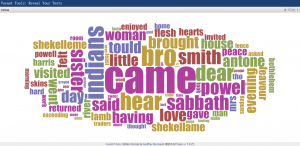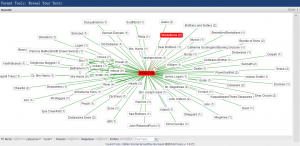Since people are usually more susceptible to visualized texts than to sequential texts, distance reading is a useful approach to answer some basic questions about the texts. It can be used to “search for patterns and to trace broad outlines” and thus provides a faster approach to the general ideas of the texts than close reading does. For example, using distance reading, we can easily find out some basic information (as the following) about the Powell Diary.
1. Was the person describing the event involved in the event itself?
As the word cloud shows below, the word Powell appears frequently in the diary, which means “yes, the person describing the event was involved in the event itself”.
2. To what degree was the experience a part of the author’s cultural heritage?
The diary is by a very large degree part of the author’s cultural heritage, because the word cloud below contains lots of words about the author’s religious faith, such as Sabbath, bro, sister, and love feast.

Moreover, the word cloud reveals the jobs and goals of Moravian. The dominate word came reveals their frequent interaction with Indians (Moravians and Indians always come and go, visiting each other). The high frequency of words such as love, peace, Sabbath and Indian can be interpreted as Moravians’ goal to spread the gospel of lord to the Indians.

While distance reading is useful in answering questions, “the goal in visualizing data from a literary text is to spark inquiry.” To me, the distance reading tools generate five questions that only close reading can answer.
- Why is Shekelleme linked only with Powell in RezoViz? How was their relationship?
- Why is Ms. Harris linked with much more people than Shekelleme do? How was her relations with Moravians?
- How was the general relation between Indians (dominant word) and Moravians?
- Who were the bro (dominant word) of author?
- How did the author spend his evening (dominant word)?
In the Whitley reading, the words of Steger “What the word cloud does not include is almost as informative as what it does” really impressed me. Prayed and lord are two under-represented words in the diary. It is quite surprising that these words does not appear frequently in a Moravian’s diary. This under-representing leads to the conclusion that Moravian valued their material life as much as, if not more than, their spiritual life. After all, American in the 18th century was not a hospitable place to live and the Moravians had much physical challenges to deal with.

While distance reading facilitates our textual reading, we can also use it to “read” pictures and photos. One of the most interesting distance reading project I found is SelfieCity. This project collects lots of selfies from different cities and analyzed them using distance reading approaches. For example, the emotions of the selfies are categorized and counted, so readers can see which emotion is prevalent in a certain city. It is the same process as using word cloud to show which word is dominant in a certain book.
Comments
One response to “On Distant Reading”
Nice work, Hannah!!!!